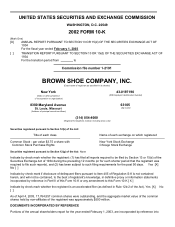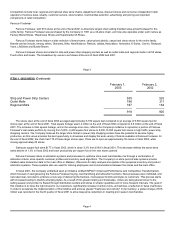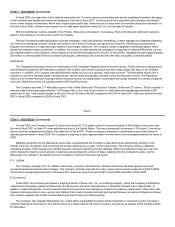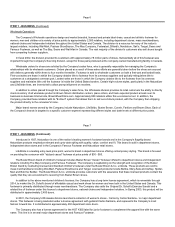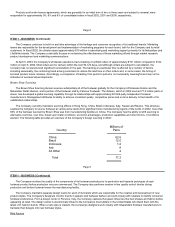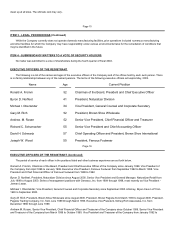Famous Footwear 2003 Annual Report Download - page 7
Download and view the complete annual report
Please find page 7 of the 2003 Famous Footwear annual report below. You can navigate through the pages in the report by either clicking on the pages listed below, or by using the keyword search tool below to find specific information within the annual report.
Certain statements herein and in the documents incorporated herein by reference as well as statements made by the Company from
time to time contain forward-looking statements within the meaning of the Private Securities Litigation Reform Act of 1995. Actual results
could differ materially. The considerations listed below represent certain important factors the Company believes could cause such results to
differ. These considerations are not intended to represent a complete list of the general or specific risks that may affect the Company. It should
be recognized that other risks (including those discussed in the Management's Discussion and Analysis section of the Annual Report to
Shareholders) may be significant, presently or in the future, and the risks set forth below may affect the Company to a greater extent than
indicated. The Company disclaims any intent or obligation to update these forward-looking statements.
Competition and Changes in Consumer Preferences
Competition is intense in the footwear industry. Certain of the Company's competitors are larger and have substantially greater
resources than the Company. The Company's success depends upon its ability to remain competitive in the areas of style, price and quality,
among others, and in part on its ability to anticipate and respond to changing merchandise and fashion trends and consumer preferences and
demands in a timely manner.
Furthermore, consumer preferences and purchasing patterns may be influenced by consumers' disposable income. Consequently, the
success of the Company's operations may depend to a significant extent upon a number of factors affecting disposable income, including
general economic conditions and factors such as employment, business conditions, consumer confidence, interest rates and taxation.
Page 10
Reliance on Foreign Sources of Production
The Company relies entirely on broad-based foreign sourcing for its footwear products. The Company sources footwear products from
independent third-party manufacturing facilities located in China and Brazil, and to a lesser extent from Indonesia, Italy, Mexico, Taiwan and
one Company-owned manufacturing facility in Canada. Typically, the Company is a major customer of these third-party manufacturing
facilities. The Company believes its relationships with such third-party manufacturing facilities provide it with a competitive advantage; thus
the Company's future results will partly depend on maintaining its close working relationships with its principal manufacturers.
The Company relies heavily on independent third-party manufacturing facilities, primarily located in China. Historically, the trade
relationship between the United States and China has not had a material adverse effect on the Company's business, financial condition or
results of operations. There have been, however, and may in the future be, threats to the trade relationships between the United States and
China, including past and future threats by the United States to limit trade relations with China. There can be no assurance the trade
relationship between the United States and China will not worsen, and if it does worsen, there can be no assurance the Company's
business, financial condition or results of operations will not be materially adversely affected thereby. Further, the Company cannot predict
the effect that changes in the economic and political conditions in China could have on the economics of doing business with Chinese
manufacturers. Although the Company believes it could find alternative manufacturing sources for those products it currently sources from
China through its existing relationships with independent third-party manufacturing facilities in other countries, the loss of a substantial
portion of its Chinese manufacturing capacity would have a material adverse effect on the Company.
As is common in the industry, the Company does not have any long-term contracts with its independent third-party foreign
manufacturers. There can be no assurance the Company will not experience difficulties with such manufacturers, including reduction in the
availability of production capacity, failure to meet production deadlines, or increases in manufacturing costs. Foreign manufacturing is subject
to a number of risks, including work stoppages, transportation delays and interruptions, political instability, expropriation, nationalization,
foreign currency fluctuations, changing economic conditions, the imposition of tariffs, import and export controls and other non-tariff barriers
and changes in governmental policies.
Further, the Company's products depend on the availability of leather. Any significant shortage of quantities or increases in leather costs
could have a material adverse effect on the Company's business and results of operations.
Page 11
Although the Company purchases products from certain foreign manufacturers in United States dollars and otherwise engages in
foreign currency hedging transactions, there can be no assurance the Company will not experience cost variations with respect to exchange
rate changes. The Company cannot predict whether additional United States or foreign customs quotas, duties, taxes or other changes or
restrictions will be imposed upon the importation of non-domestically produced products in the future or what effect such actions could have
on its business, financial condition or results of operations.

